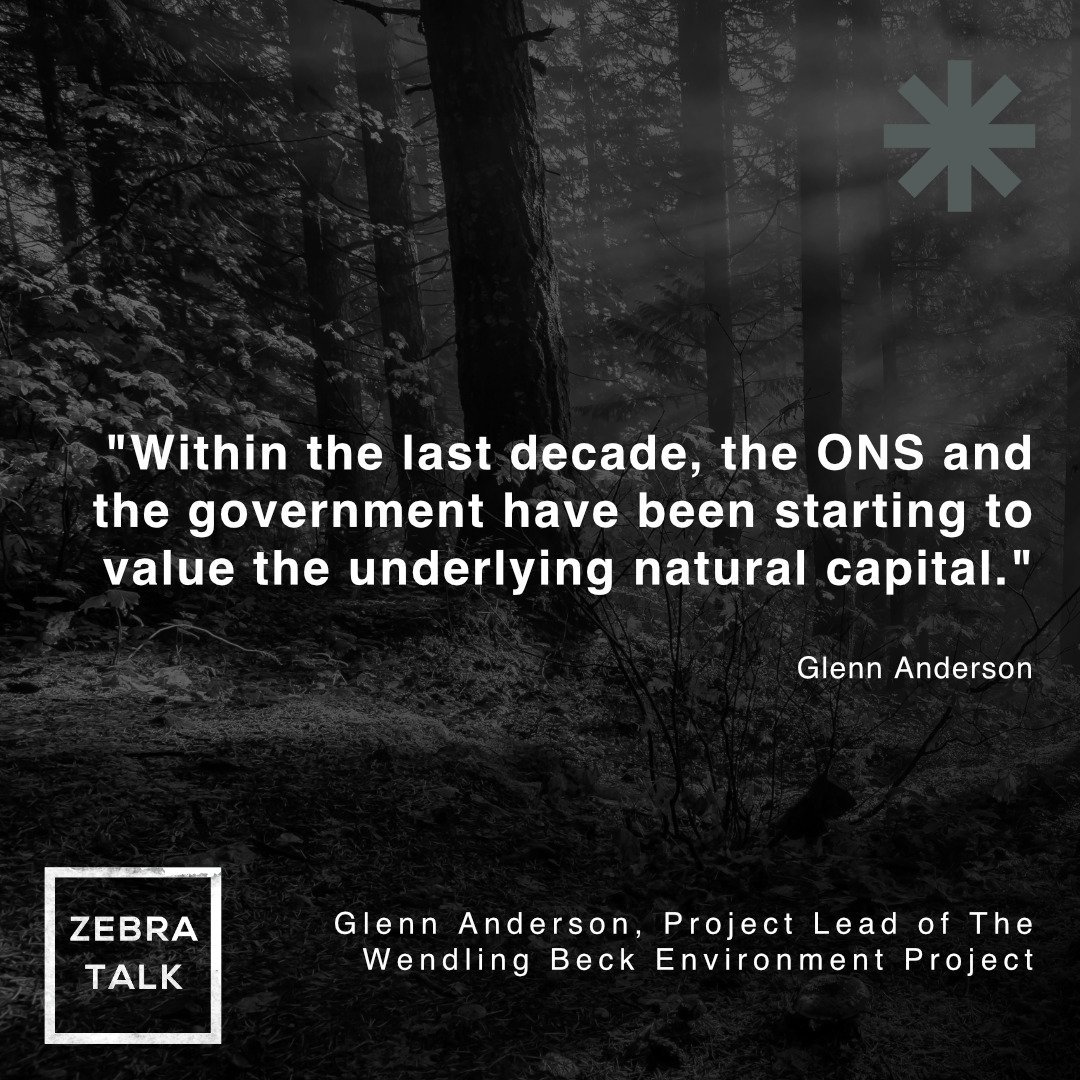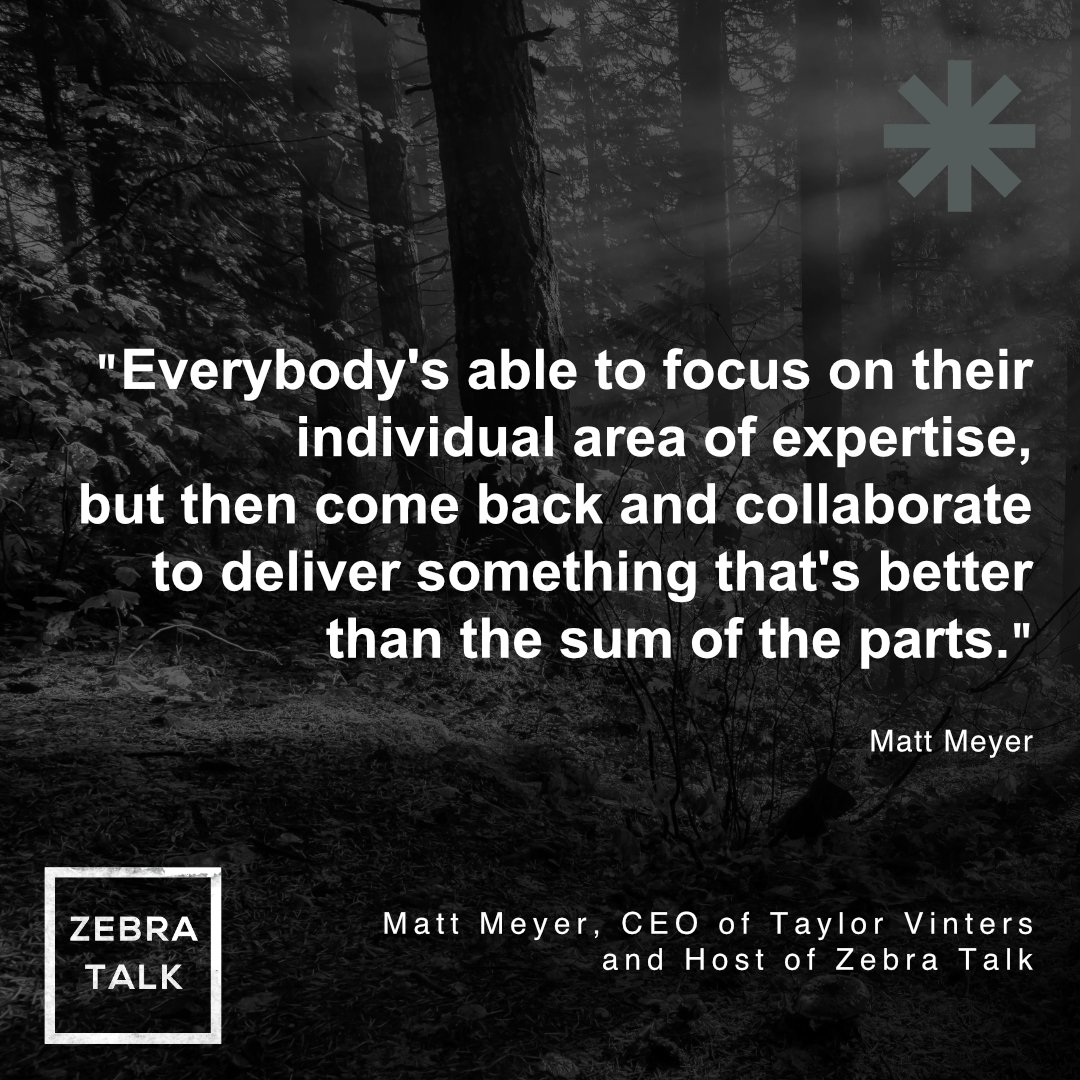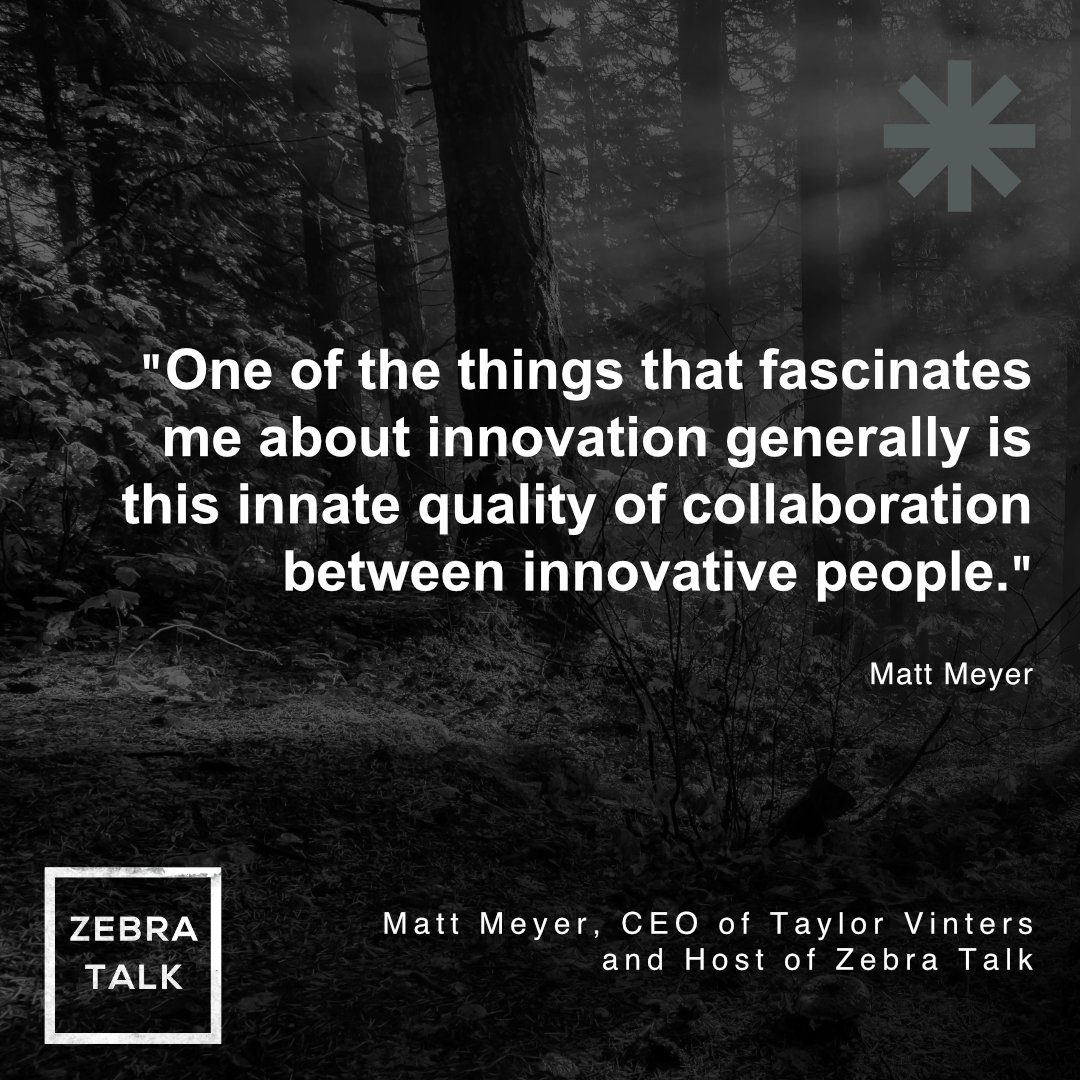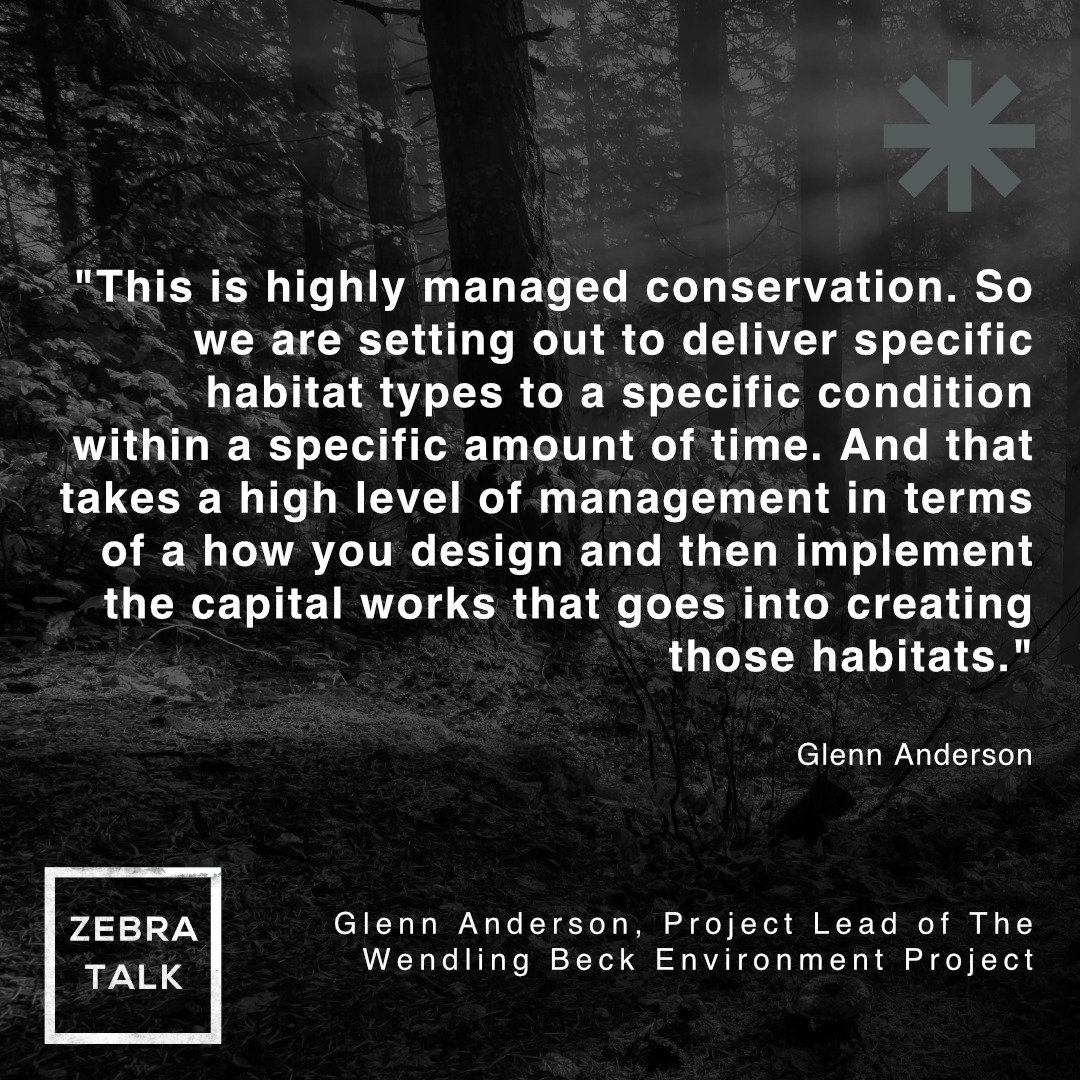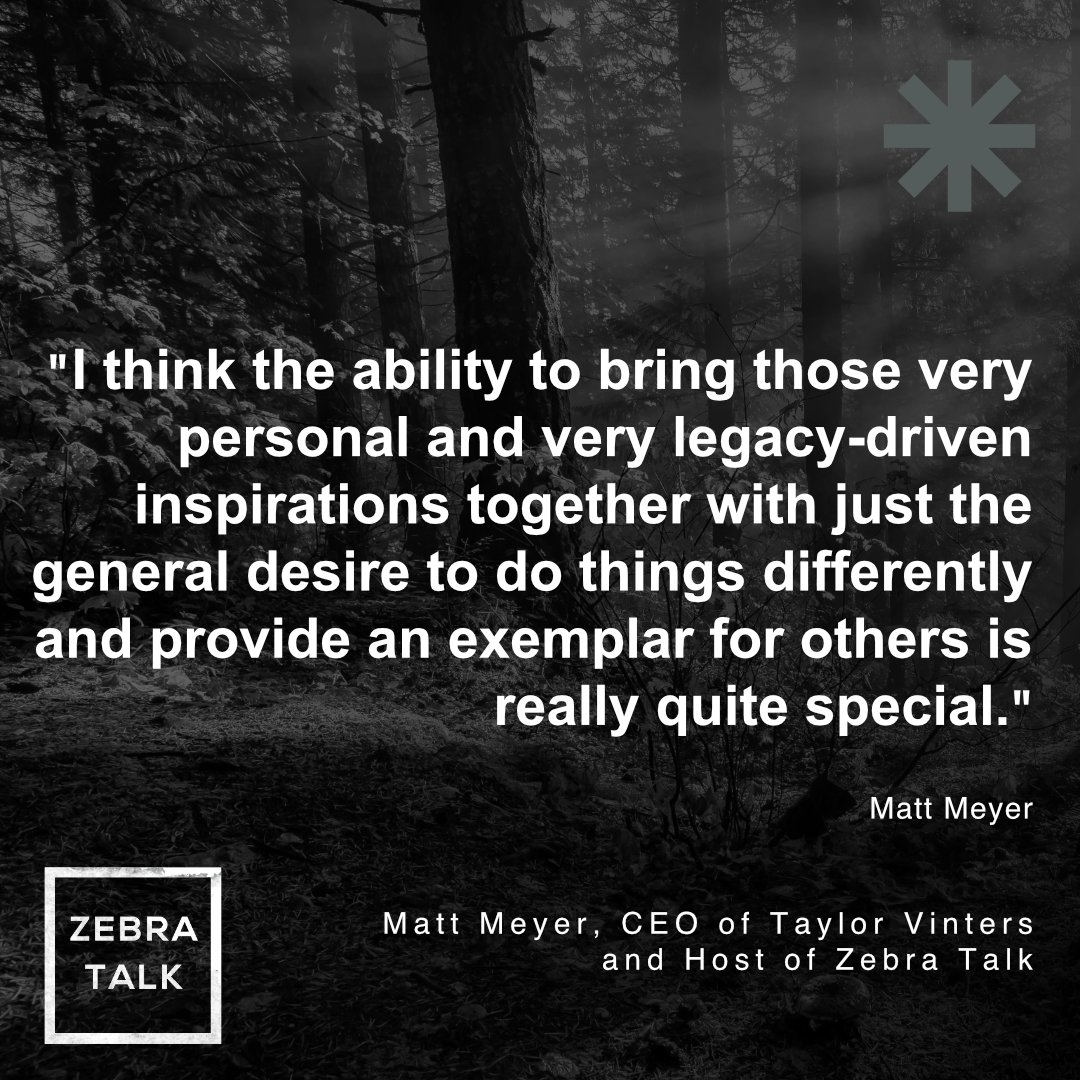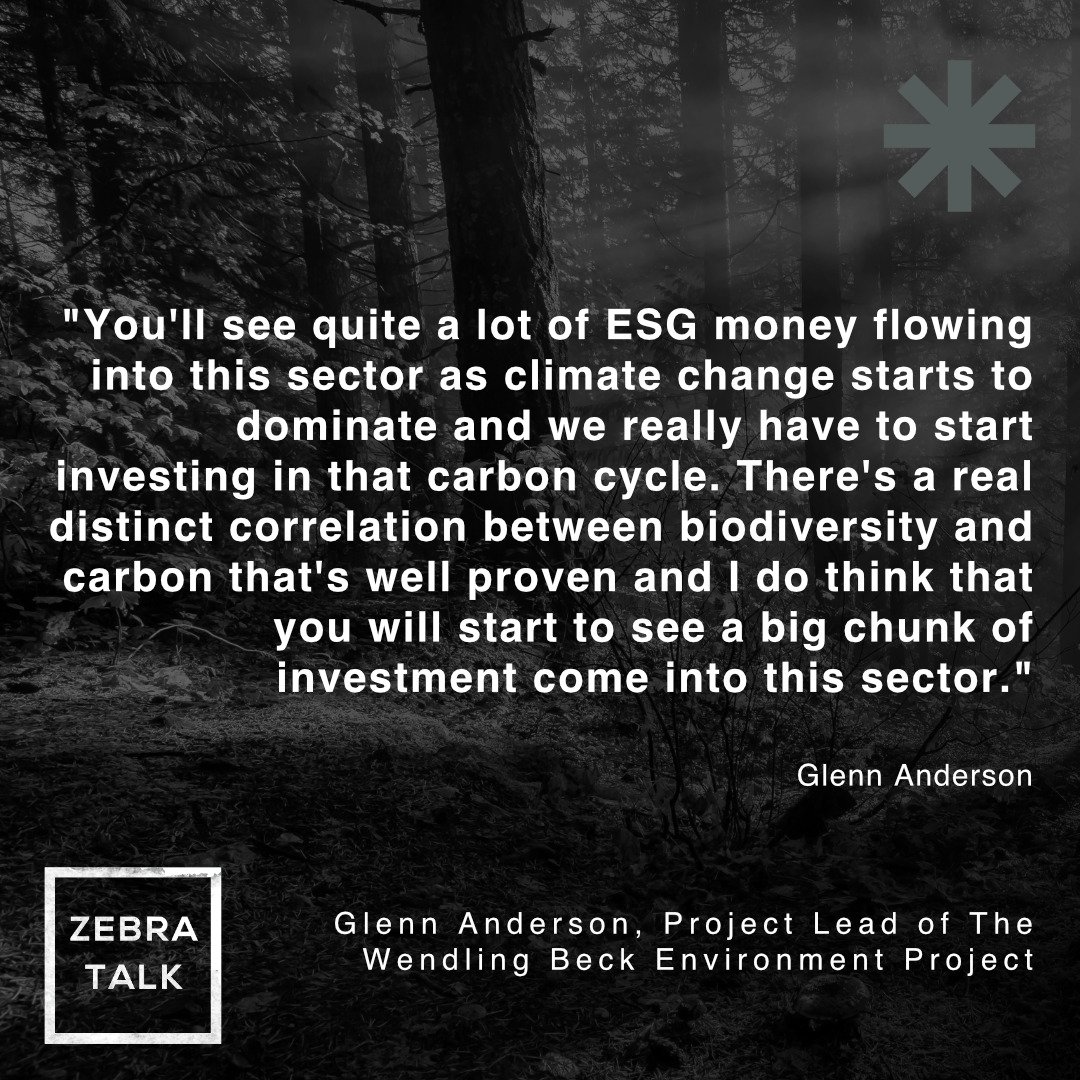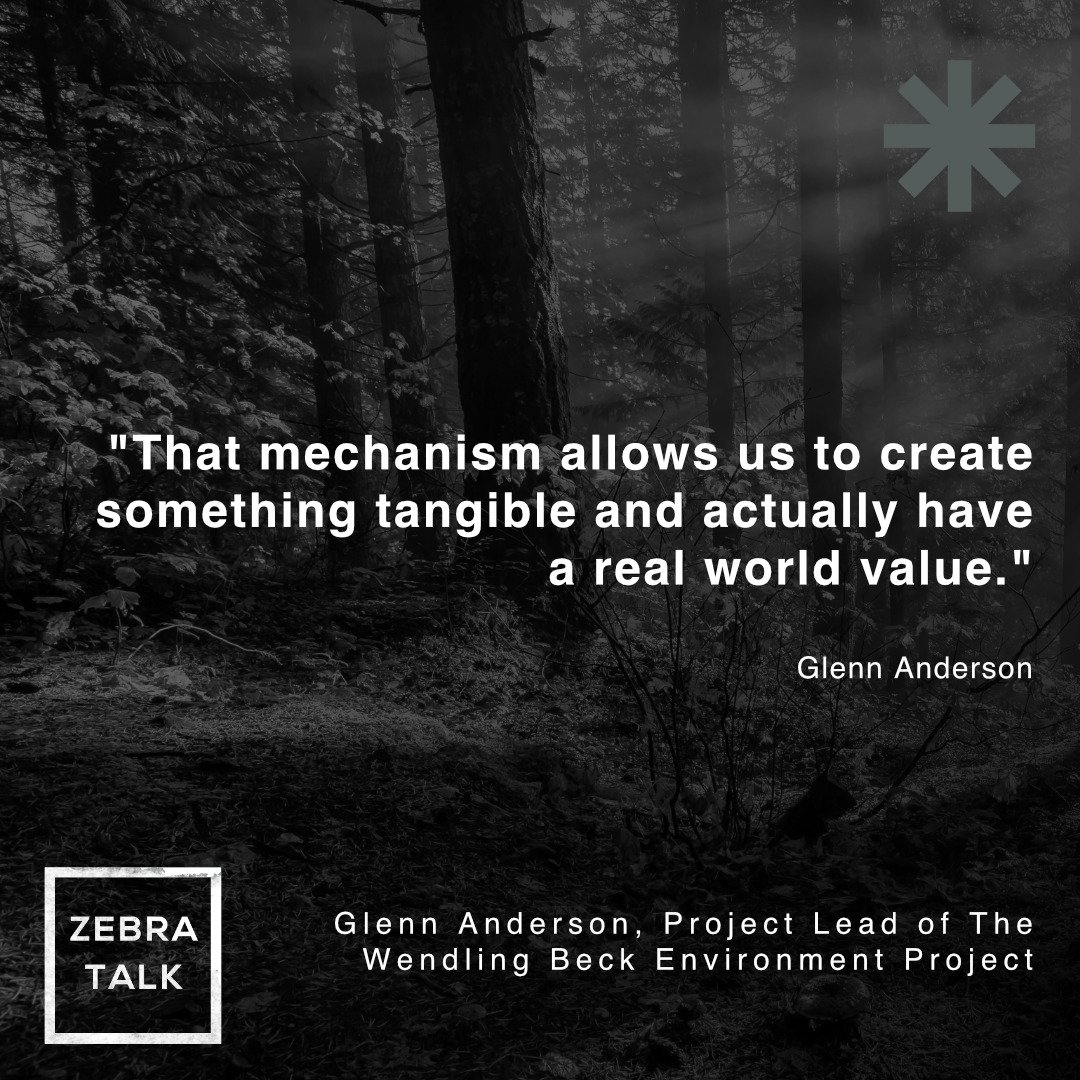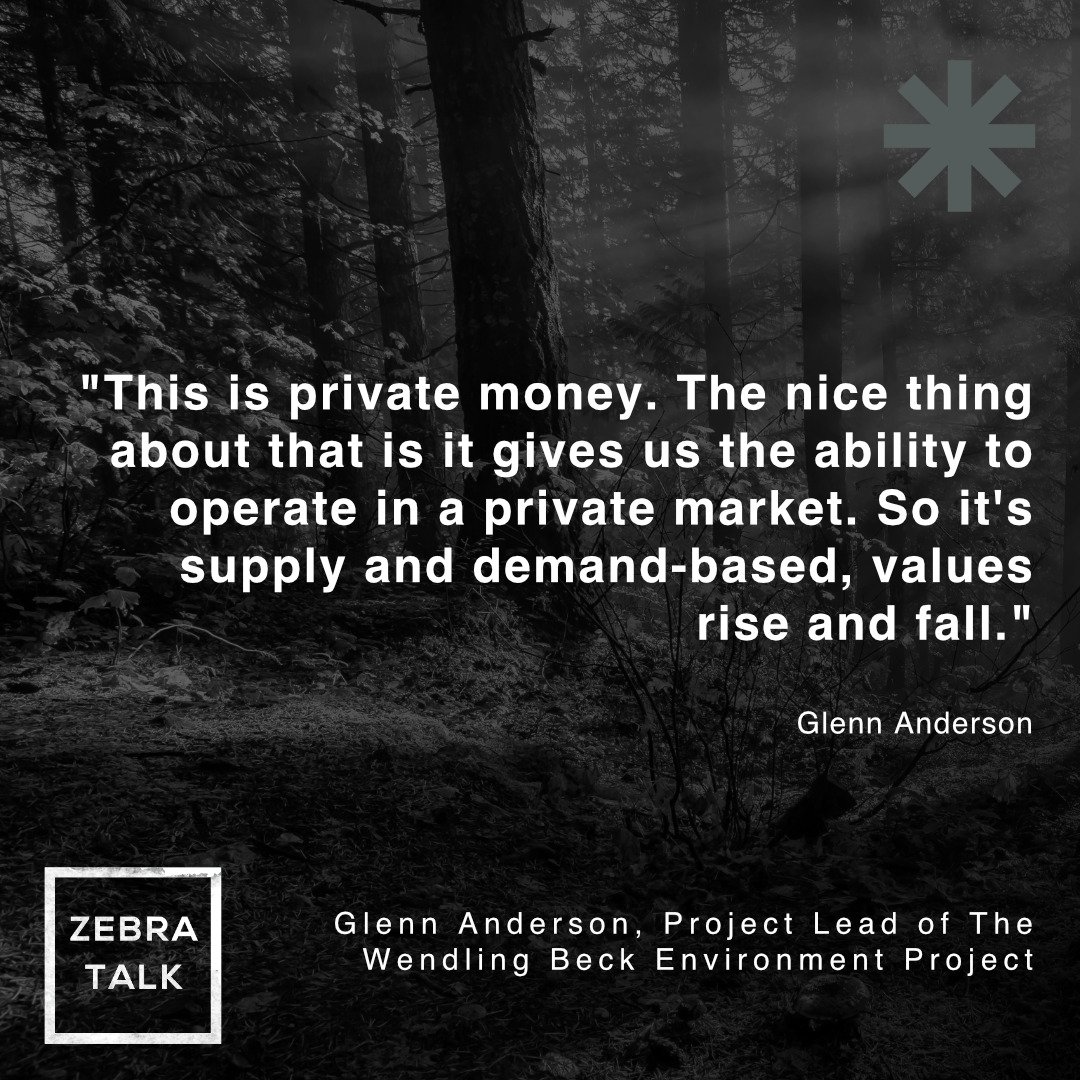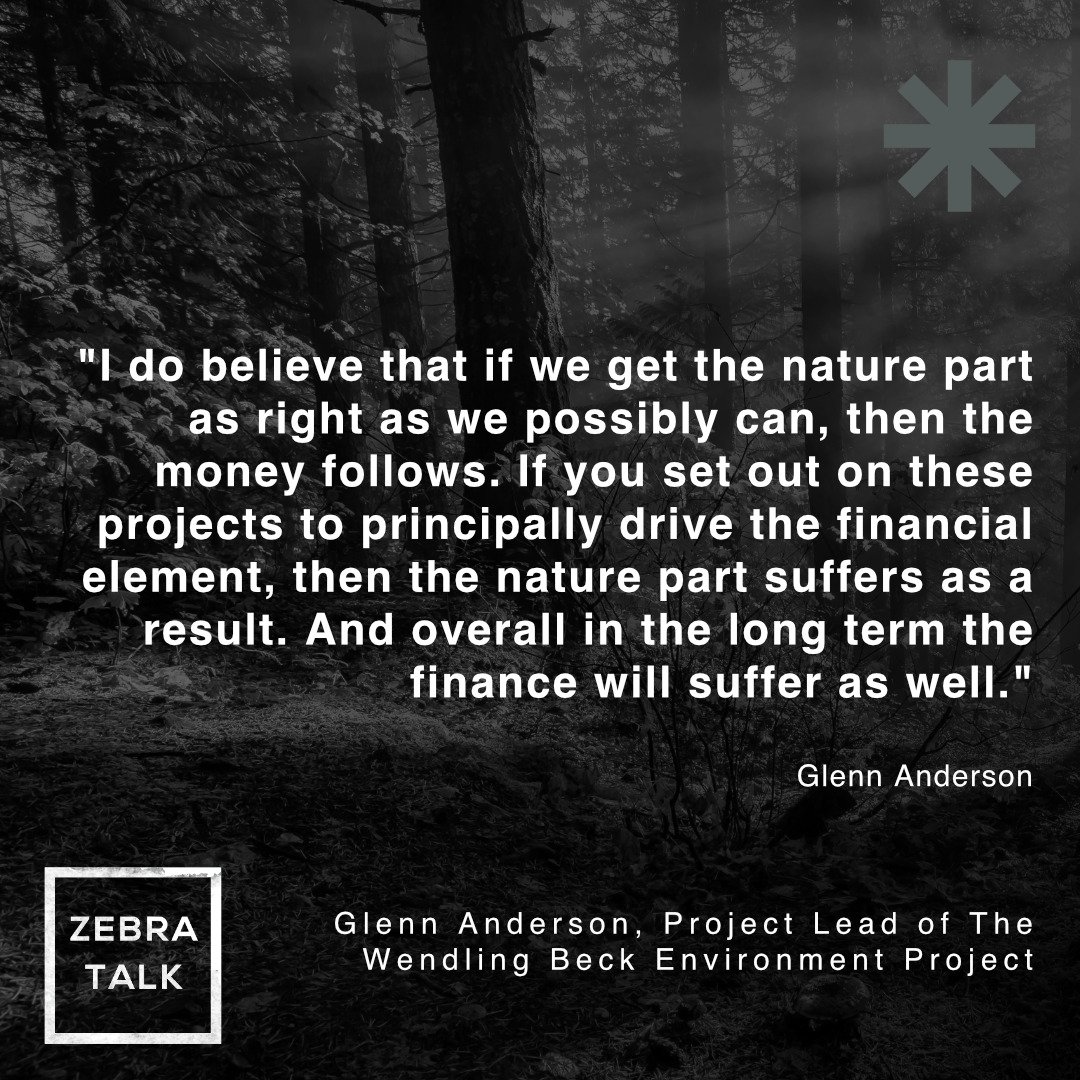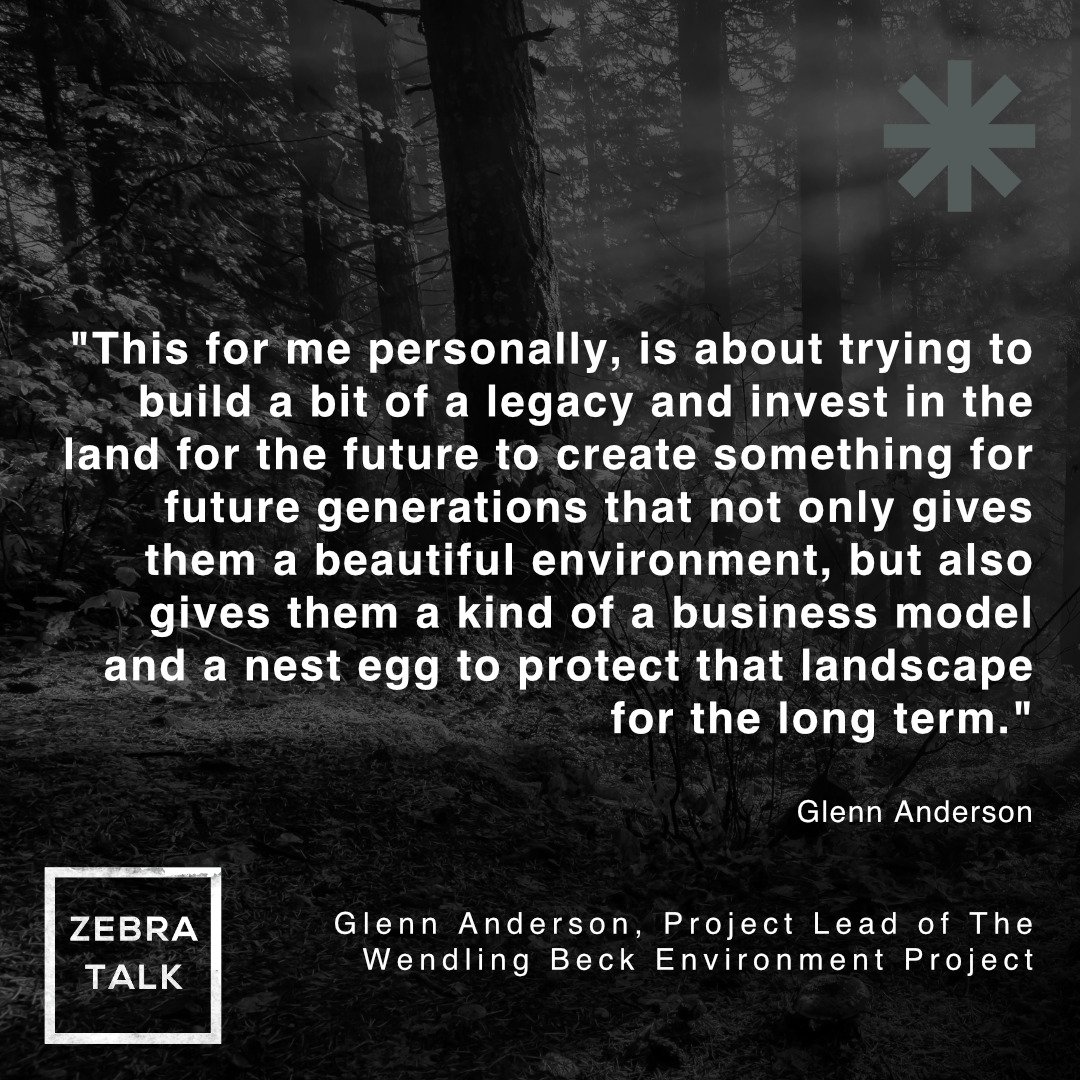ZEBRA TALK - The power of collaboration: building resilience and real-world value with a nature-first approach
In conversation with Glenn Anderson, Project Lead of the Wendling Beck Environment Project. Talking with Matt Meyer about the vital role of natural capital in global economies, the growing risk to food security, the importance and reward of investing in nature, how collaboration brings about real-world change, creating a blueprint to protect the planet for the long-term, building environmental resilience and how it feels to be delivering something so spectacular that we may not get to experience the impact of in our lifetime.
Explore key soundbites, listen to the full podcast or read the transcript of Glenn’s inspiring episode of Zebra Talk below.
KEY QUOTES
SOUNDBITES
PODCAST TRANSCRIPT
Please note that this transcript is auto-generated from the audio file through Rev - Humans Working Side By Side With The Best Speech-to-Text AI. We believe this to be a good representation of the conversation, but it isn’t checked word-for-word and therefore isn’t 100% accurate.
Matt Meyer (00:00):
Glenn, welcome to Zebra Talk. It's fantastic to see you. Last time I saw you, which was only a few weeks ago, was up in Norfolk, and that was an absolute pleasure to get out and about and see the real Wendling Beck Project. Just for regular listens to the podcast, we're normally talking about market innovation, we're talking about entrepreneurship, we're talking about organizational psychology and the future of organizations. We've got a slightly different tack here today talking to Glenn, but I promise that all of those themes are interweaved into this project. What we are talking about is the Wendling Beck Project. Just to start us off, Glenn, I wonder if you could just tell our listeners what that project is and try to bring it to life as a physical project as well as a business project.
Glenn Anderson
Yeah, thanks Matt. So the Wendling Beck is a landscape scale nature restoration and habitat creation project. It's right bang in the center of Norfolk and it's looking at new mechanisms within the policy arena to try and monetize that. So we are moving away from a typical farm landscape and looking at how we can use new policies to underpin new finance regimes, if you like, to build some resilience into their existing businesses. It comprises of four different farmers and four farms within that holding. We also have Norfolk Wildlife Trust and Norfolk County Council of Landowners in it. And the wider collaboration actually brings in the Nature Conservancy who are a big American nature NGO, Norfolk Rivers Trust, Norfolk Farming and Wildlife Advisory Group. And then we actually have Anglian Water as a private sector organization helping us as a mentor, but also as a kind of buyer of environmental credits as well. So it's very collaborative and we're starting to see that collaborations are quite a rare thing in this field. Farmers don't naturally collaborate terribly well together. I think that's something that we will see in the future, and certainly government policy is trying to encourage farmers down that avenue. So that's kind of us in a nutshell.
Matt Meyer (02:21):
If our listeners were looking at the Wendling Beck Project what would they see? I mean, what does that look like from a physical perspective?
Glenn Anderson (02:28):
So it's a big block of land just under 2,000 acres just north of the market town of Derham. It has a river, the Wendling Beck river from where the project gets its name, which is a small chalk stream running right through the middle of it from south to north. And then it has two kind of big lungs if you like, if you were looking at it from a bird's eye view. And they are currently in quite intensive arable operations. We do have some blackcurrants. So we have a blackcurrant farmer amongst the mix as well. And we will look to retain some of that blackcurrant production, but in a more regenerative system as we go forward.
Matt Meyer (03:07):
When I summarize the projects in my head, I think, and I'll do this in a crass way so you can challenge me around it, but I kind of think that the canvas that you are painting on is a natural one. It's a landscape canvas that you're painting on, but actually what the project is exploring is something very commercial, which is, how to innovate in the way that you can commercialize and monetize the value of land going forward. Is that too simplistic?
Glenn Anderson (03:35):
I think it's maybe a bit narrow, so I think it's probably a bit wider than that. I think we are really looking at how we value natural capital and looking at that kind of natural capital account within the land holdings. And this is something that's relatively new, certainly new to us, but it's relatively new within the finance institutions as well. But within the last decade, the ONS and the government have been starting to value the underlying natural capital. So if you think that the natural capital is everything that we get for free from nature, but it actually underpins about 40% of all of the economies globally. So we are really looking at how we can invest in that because as a species, we're actually eroding our natural capital much faster than nature is able to replenish it. And if you think that that's underpinning the entire financial markets and all of the institutions, then that's not a great long term prospect. So that's where this interest in natural capital is coming from. We're really looking to build some resilience into it. So that it’s actually there for us in the future.
Matt Meyer (04:48):
I know from our previous conversations that part of the catalyst for you personally getting interested in this was a deep sense of the need to respond to not only the climate threat, but biodiversity challenges more generally. From a commercial perspective, for landowners, for farmers, there was another catalyst which was the removal of the subsidy system. Is that a key driver in this project for you still or is that broader desire to think about the value of natural capital really the driver going forward?
Glenn Anderson (05:20):
I think at the outset it was a big driver for us. The rationale for this project was ‘we are on very light land here’. The landowners were aware that the subsidy regime was going to be phased out. Subsidies for us are the mechanism that underwrites the risk of production so the thing that says: ‘Well, we've just lost some money this year because we've had a drought, but we're still going to plant something next year’ because you've got this underlying safety net being subsidies. Without them in place, it makes that prospect quite difficult. There's only so many years on a light land farm that you can do that. And farming generally is hugely at risk from climate change. It is the single biggest risk to food security. So we needed to look at how we were going to build some financial resilience into the business going forward.
(06:11):
Ecosystem services, as we call them, looking at investing in nature was a great opportunity for us on land that is not particularly productive and we can still weave some kind of food production within the story as well. So we don't want to move away from that completely. We're ultimately, still farming the land, we're just creating a lot more nature. So for example, we'll use livestock to manage the habitat, but that will also go into the food chain. At the moment we're growing cereals and pulses, which will go into livestock feed. That's quite a carbon hungry process. We can kind of cut out the middle man, if you will, and have the livestock on the grass in the first place and have a much more efficient and much more sustainable way of doing things. So I guess subsidies, or the loss of subsidies took us down this route, but as we've gone down this route, it's become a bit more holistic. We're very aware that this does need to stand on its own two feet. This is about creating a template and a blueprint that other landowners can adopt. So it needs to stack-up financially. We're not afraid of that and we're not shy about that. It needs to be a successful financial mechanism, but it should also build a tonne of environmental resilience into these businesses as they move forward.
Matt Meyer (07:32):
I think that that idea that it can be a model that's replicated is a really interesting one for me and a very innovative one. So I'd love to come back to that, but before I do, I was just going to ask you - a number of our listeners will be familiar with projects like NEP and they'll have heard the phrase rewilding. How is this different to a pure rewilding project?
Glenn Anderson (07:52):
So rewilding is non-intervention. It's where you just let nature take care of itself. This is highly managed conservation. So we are setting out to deliver specific habitat types to a specific condition within a specific amount of time. And that takes a high level of management in terms of a how you design and then implement the capital works that goes into creating those habitats. But then how you maintain those over time with factors like climate change which make that very difficult and that whole management regime with livestock and removing nutrients from the landscape and allowing those kinds of natural species to thrive. So rewilding is very much about allowing natural processes to just do their own thing. We are accelerating natural processes in some ways because we are able to do that through the design and the management.
(08:50):
So ultimately we will create a much wilder landscape and in some ways I think that we will end up in a similar place and we're actually working with NEP - huge amount of respect for them as a business. They were really the pioneers on a lot of this, but we're taking a slightly different approach. What we are seeing is as they go through the transition, and they have some fantastic habitat there already, nature wants to (through succession), move through some of those optimal habitats to something else. Ultimately a lot of habitat will revert to woodland, so there is an argument that they might need to intervene and if they want to keep some of the habitats they've created at their optimum performance, then that will take some management as well.
(09:36):
So I do wonder whether we will end up in similar places but through a different journey. And I also wonder whether we'll be able to get there slightly quicker than nature would do on its own. The other thing just to mention is many of the really high quality habitats, the triple SI’s and the protected sites that we have within the UK are actually either re-naturalized man-made landscapes in themselves or have had quite a lot of human intervention at some point in the past. So there are very few really wild habitats left, certainly in the UK, but really across the world, unless you've got true wilderness where you've got apex predators and they're moving on big herbivores that are managing that habitat, then you don't really get true wilderness. Humans are everywhere and our footprint is quite heavy on the planet, so it's kind of a moot point, but we'll create a wilder landscape and hopefully it'll be a great place that people will come and see and enjoy.
Matt Meyer (10:36):
I love that idea of accelerated conservation. When I visited the project, it looked like a lot of patience was going to be required to see it through.
Glenn Anderson (10:43):
Yeah, it's a really long term process. So we've really only just started on this journey - out of the 2,000 acres of project area, we've done about 175, something like that, that's with various different habitat types. So we're only just scratching the surface and it's only a year down the line. So there is a pain barrier to go through. We're getting quite a lot of big weed burden at the moment as we go through and manage that over time it'll just get better and better. I think by year three you'll start to see the shape of what's coming and then obviously it's a really long term process. I mean it's a minimum of 30 years. Some of the policies that are underpinning this like biodiversity net gain, it's actually embedded within the policy that it needs to be there for 30 years. But really this is an IM perpetuity vision. So we expect to deliver this and it's just there for generations to come and hopefully that habitat will transition into something really spectacular. Whether we get to see that within our lifetime, I'm not sure, but a lot of the really great landscapes within the UK were envisioned by people that never got to see the best of them.
Matt Meyer (11:53):
It's a fascinating mindset and an impressive one, and I definitely admire that approach and I guess that's one of the points of difference from many of the other innovative businesses that we might talk about is the timeframe involved in most – most of the founders that we deal with are looking for five to 10 year return and exit. The idea that you might not even see it in your lifetime is interesting in terms of you being a founder, if I can call you that. But perhaps more importantly from an investment perspective, I mean it must be a difficult backdrop against which to seek investment into those kinds of projects.
Glenn Anderson (12:25):
We're seeing more and more interest in biodiversity, carbon and natural capital and my sense is there's a huge amount of money and institutions out there that are looking for projects to invest in. What they're lacking at the moment is any sense of certainty, if you like. And I do feel that some of these markets need to take a little bit more risk. We are seeing more projects emerge, but we are trying to build a 50- to hundred-year investment model. Investors might come and go through the cycle of that. We're seeing some interest in sort of regulated market exchanges where they're looking to strip these projects down and kind of repackage them into five years sort of investment cycles. And I think that's an interesting prospect. I'm not a financier, I don't really understand exactly how those markets work. It's really interesting that there's organizations, asset management companies and banks out there that are really looking to start investing in this. And I can see that coming. I think you'll see quite a lot of ESG money flowing into this sector as climate change starts to dominate and we really have to start investing in that carbon cycle. There's a real distinct correlation between biodiversity and carbon that's well proven and I do think that you will start to see a big chunk of investment come into this sector.
Matt Meyer (13:45):
I definitely share your optimism about that and am certainly hearing those noises in various markets and starting to see that investor interest if we agree that there's an investible proposition there, which I think we do. Perhaps if you can help our listeners understand what is the tradeable element that comes out of the project. What is it that can be monetized?
Glenn Anderson (14:05):
We're in a relatively unique position within the UK because we've obviously come out of the European Union. We then had an agriculture act sort of swiftly followed by an environment act and that actually laid down a few key policies for us. So one of those being biodiversity net gains. So that's embedded within the Environment Act, it's primary legislation. That's the principle that a developer, to get planning permission, will require any habitat loss within the development site to be offset or to be replaced within the footprint of the development site. So we know that within brownfield sites developers will be able to offset most of that within the footprint of the site, but once you get to greenfield sites, that becomes much more difficult. So they have the option of offsetting some of these habitat units in dedicated projects, ideally as close to the site as possible, although that's a kind of policy instrument that does start to create a tangible market within this sector.
(15:08):
So that gives us something that we can create, we can create biodiversity units through the creation of habitats and then sell those to developers. So that's one example. We then have policies like nutrient neutrality. So we're seeing that here in Norfolk that they can't build any overnight accommodation without offsetting that nutrient load, making sure there's no adverse impact. So that goes back to a Dutch court case against the Dutch government and we we're sort of seeing a few challenges to that at the moment. But my sense is that within the development sector that they've accepted it now planning is on hold across quite a lot of the planning authorities where this is happening because at the moment we haven't got the solutions in place, but they are coming down the line fairly rapidly and hopefully that will free up the planning system. But again, it's an example of how that's monetized. So although these are government policies, the government wants to be fairly hands-off in how this is regulated and monitored after that process. That mechanism allows us to create something tangible and actually have a real world value. You don't get that across Europe because these policies aren't in place. There are examples of it elsewhere internationally, but it does give us a great head start for the ability to start to really sell environmental credits, basically.
Matt Meyer (16:24):
That market innovation aspect, that creation of a brand new market. It’s something fascinating here and I'm pleased to see the UK leading the way and helping develop that through projects like Wendling Beck. Listening to what you're saying, I'm sure listeners will be thinking, well is this government policy driven in terms of the offset schemes? Surely this must be a public money type project, but from what I'm hearing this is principally funded by private money. Is that right? And how important is private capital in this system?
Glenn Anderson (16:49):
This is private money. The nice thing about that is it gives us the ability to operate in a private market. So it's supply and demand-based, values rise and fall. It means that we are not monitored constantly as we have been in a subsidy regime. You've always got the RPA looking over your shoulder and making sure that you are compliant with their rules and regulations. So it is still fairly heavily governed in the regime of the policy. But it is a private market and frees us up to work in a slightly different way. We are seeing examples where government wants to see this blended finance model. So this is the principle of using public and private money to fund some of these projects. And we've heard the terms of public money for public goods, we deliver that within this project.
(17:35):
But we are still creating quite a lot of public benefits that we are not necessarily monetizing. So things like air quality, health and wellbeing, access to nature, access to open space, public access routes and things like that. We're not charging for that, we're not creating any form of credit from that. They're a co-benefit of what the private market is driving. So hopefully that's a win-win. We can start to value that. We can value that within an actual capital accounts and those values back to society are quite significant, but they are a co-benefit. So it's a good example of government creating a set of policies which stimulate the private markets but then end up with multiple co-benefits which benefit the public.
Matt Meyer (18:21):
Yeah, absolutely. And I think again on the podcast we talk a lot about impact on that sort of broader societal benefit as a sort of tangible by-product of what's going on. I think that’s really, really important for people's engagement and interest in these sorts of projects. We've talked a fair bit about finance and money. You used a phrase last time I met you, which was nature first, finance second, and I just wondered what that actually meant to you personally.
Glenn Anderson (18:43):
When we started the project, it was mainly financially motivated. So we were really looking at how we could build some financial resilience into the business but also take the opportunity to reduce our carbon footprint and actually do something for nature at the same time. I think as we've gone through the journey, we've become a bit more altruistic about that. And I guess as part of the design process have really focused on the nature part, so to the point where it's become probably more important to us than the finance part. I do believe that if we get the nature part as right as we possibly can, then the money follows. I think if you set out on these projects to principally drive the financial element, then the nature part suffers as a result. And overall in the long term the finance will suffer as well.
(19:38):
Whereas if you really invest in the natural piece of it, then it opens other opportunities. So an example of that might be, we are creating habitats and creating this landscape to deliver biodiversity, which we can then sell credits for. But actually if we create this beautiful environment, people want to come and see that and maybe there's an ecotourism model which sits on top of this, which we haven't even built into our financial projections. So you start to get accumulators in the finance model which are really founded in the quality of the delivery and creating something amazing and beautiful that people want to experience.
Matt Meyer (20:23):
I really like that phrase accumulators, I think that captures a lot of what we've talked about and what you were trying to create. Perhaps in a moment we can talk about some of the spin-off benefits and spin-off projects that have come from the work that you've done. But I just wanted to pick up on, I guess my interpretation of what you mean by nature, but I've been struck that if there's a lot of conversation about climate, there's a lot of conversation about carbon. Some of these projects, particularly this one, are very rooted in not just that but in biodiversity generally as a public good, as a positive thing in society. To what extent is biodiversity the sort of poor relation of climate change in the public opinion in your view?
Glenn Anderson (21:01):
Well, we know there's a really close correlation between the two and I'm not expert on this, but there are definitely experts out there who are starting to provide metrics on the beneficial carbon effects of different species on the planet. And that has a kind of real world value. So that's where you start to see David Attenborough in blue planet start to put a price on a blue whale and I can't remember what that figure was. There are people out there that are starting to value natural assets and individual species and you can convert that back to a carbon cost as well. I think people experience climate change first-hand. So we've just come out of a very, very hot summer and a major drought. Now everybody in this part of the world realized that was not something normal and that actually we're starting to see the effects of climate change first-hand.
(21:58):
Whereas biodiversity is probably a bit less understood and people still see species in the countryside as they're out and about. And I think there's probably quite a lot of farmers that still feel that they've got some good levels of biodiversity, different species because they see them. But I think what we've really lost is the abundance of species. And if you think about when you're just driving around the countryside on a summers’ evening, you don't get anywhere near the amount of bugs and flies and stuff on your windscreen and your bumper that you used to. And that has a knock-on effect all the way through the food chain. So we know from the species surveys that we are doing now compared to historical species surveys that many of those species have got nowhere near the number and abundance that they used to have and some of them have been lost entirely.
(22:47):
So it's really important that we do invest in biodiversity. I think there's a distinct correlation between the two. Ultimately, I'm not sure it really matters because I think the two are so closely related that whether you are investing for carbon or you're investing for biodiversity, you're going to get both within the government regime. We don't actually look to individual species to reintroduce back into the countryside. We're about creating habitats, the mantra being that if you create the habitat, the species will come. So hopefully that will be the case and we're quite confident that it will be.
Matt Meyer (23:22):
We've identified a couple of times potential spin-outs and spin-offs from the project that you're doing and the ecotourism was an interesting one, but I wonder what other business ideas and business models are flowing out from the work that you are doing. What other ideas are you incubating and also who's copying you, what's happening around the country that's based on this project?
Glenn Anderson (23:43):
We're building up a level of expertise as we go through the process and a lot of this has never been done before, so we don't really have a template to copy. We're talking to as many people as we can. So I gave the example of NEP, we've got a great working relationship with them and we are learning from them and hopefully they'll be able to learn from us as well as part of that kind of knowledge bank we are just tentatively looking at building a consultancy. So we have just set up a new company and are in the process of creating a consultancy with some of the key expertise that we've got around this project, to be able to help other projects. So that's one example. We're also seeing other projects come to us to learn different pieces and we're just looking at another project in Cambridgeshire, where we are looking at basically replicating this model.
(24:36):
It's a completely different farm type, but we do feel that we can deliver a really successful model there. It's a really interesting project. So as we go through this, hopefully we can replicate and scale, because Wendling Beck on its own is a nice to have in Norfolk, it's great for the town of Dereham. It's right on their doorstep. We're walking distance from the marketplace, that's great, but it doesn't change the world, it doesn't save the world, it doesn't reverse climate change. But actually if you can take that model and replicate it and you get that finance model right to the point where other landowners and land managers want to adopt it because it's successful, then potentially that does change things a bit. And that does have a, a much wider, greater impact, not necessarily just in the UK but internationally as well.
Matt Meyer (25:26):
One of the things that fascinates me about innovation generally is this innate quality of collaboration between innovative people. And I think people tend to think of innovation as being very proprietary and private, but clearly there's a high degree of collaboration in this project. And more broadly, I'm fascinated by how you make that work on the ground, particularly with farmers. I mean, they will not cast any aspirations. Farmers are often considered to be quite private people, quite territorial people. So how have you actually made that work in practice?
Glenn Anderson (25:53):
We were very fortunate on this project that we had four landowners that were very likeminded. They were in similar positions where they had other external businesses as well away from the farm and maybe a slightly broader view of the kind of the wider world if you like and almost weren't stuck in that kind of hamster wheel of production. So I think farming is quite a high pressure industry - you're working against the weather all the time, you're constantly trying to get things cultivated, get things drilled, get things sprayed, get things harvested. You never have time to actually sit back and reinvent your business. Even a small change within a farming business is quite a lot of effort. These farms were a little bit more hands-off I guess. So none of us actually spend a huge amount of time sitting on a tractor.
(26:44):
We are using contractors in various different guises. We do have in-house labor and machinery. We had the ability to just take a slightly different view of how these businesses should be in the future and hopefully we can help other landowners by having gone through some of the pain as well. In terms of collaboration, it has still been quite hard work, particularly on the legal side - so to create a single operating company that represents multiple landowners is actually quite difficult. We've got different business structures within there as well. We've got partnerships and limited companies that you're trying to bring together under one umbrella. And then we've got all of the kind of the policy mechanisms and instruments. There's a new law coming out on the 1st of October, I believe, called a conservation covenant, which will bind the land holding to a responsible body for the duration, whatever action you're taking for nature.
(27:39):
So these are all new things that we're testing. The best way to try and sell this to another farmer or a landowner is really through proof’s in the pudding. So if we can create an exemplar project, everybody wants to kick the tires. Farmers are quite skeptical people, they don't like change - nobody likes change, but farmers find that quite hard to adapt to simply because I think they're in this high pressure production system always fighting against the weather. So we have started having these conversations outside of the project, but the best way we think we can do that is to create it and then let people look over the fence and see whether they want to be part of that.
Matt Meyer (28:17):
I love it. Exemplar is absolutely the right word for what you're trying to do. You mentioned in there that a number of the other people in the project had broader interest than just farming. Maybe just pick up a little bit on that and what's your own background and what skills from outside the industry do you think you brought to the project?
(28:33):
So I grew up on a livestock farm in Cambridgeshire – a fourth generation farm. So my family has been farming for as long as anybody can remember, but then I went and did something different. So I actually studied furniture design. I went to work for a big global furniture manufacturer and then ended up in consulting. So I started doing sort of commercial real estate for big blue chip organizations. So that kind of consulting mentality has probably helped a bit. It certainly helped us in terms of writing grant bids and proposals and things like that, but it also gives you a bit of a wider perspective of business and life and everything else. One of our other landowners came to the project full time. His background is in finance and he was actually at the National Trust before he came back to the farm.
(29:26):
That again, it gives us a bit more breadth. It gives us a better understanding. He's our in-house financial expert now. He's now leading on natural capital accounting as well. So that's super helpful. One of the other landowners actually was in the Marines, so he's got some pretty amazing experience and a broader mindset. So yeah, I think the other guys as well, they've all got different skills and we are focusing on different elements of the project. So Rosie, who's a next door landowner and a kind of a key part of starting this project is now becoming expert in regenerative farming and going through her kind of soil web training and that sort of thing. So that gives us another element to the project and everybody's able to focus on their individual area of expertise, but then come back and collaborate to deliver something that's better than the sum of the parts.
Matt Meyer (30:17):
Yeah, really interesting see so many examples of great businesses that have come from taking inspiration from other industries and experience from other industries and translating them into a problem that needs solving or an opportunity that presents. And being able to do that as a group rather than just as an individual is, is a really special opportunity. Finishing up our conversation, I'm really interested to know, and if you haven't done this, what's the alternative to this on your own land?
Glenn Anderson (30:44):
I think we would've been quite stuck. You just continue in that production cycle, I guess, and you just hope that the weather's a bit kinder to you, but our land is really light and we suffer particularly from drought and this year was horrendous, so we've had one of the worst droughts in living memory and that becomes quite difficult. So I think honestly I think we would've pushed the regen production thing. So regenerative agriculture being the principle of cutting nitrogen use and agrichemicals through having more of a natural balance within the soils and the way the water is used within the soil and the crops and stuff. And we did start looking at that initially and then kind of really got into the kind of nature creation piece. So that's probably the route that we would be heading down again, even on these soils, that would still be quite a challenge.
(31:36):
The other option is that you just sell up and go and do something else. Ultimately this is our home as well. And I think that's probably a distinction between farming and any other industry is, it’s a lifestyle choice. Farmers tend to live close to the land that they farm, walk the land every day. You do become sort of emotionally attached to it. This for me personally, is about trying to build a bit of a legacy and invest in the land for the future to create something for future generations that not only gives them a beautiful environment, but also gives them a kind of a business model and a nest egg to protect that landscape for the long term.
Matt Meyer (32:19):
Those motivations are as good as any that you'd need. But in addition, I would say that there’s as much innovation and entrepreneurialism in your project as any other sector or technology sector. So I think the ability to bring those very personal and very legacy-driven inspirations together with just the general desire to do things differently and provide an exemplar for others is really quite special. Glenn, it's been fantastic talking to you. I hope that at the right time in the project, our listeners can get themselves up to Dereham, Norfolk and can have a look around your good work and I wish you the best of luck.
Back to the ZebraTalk home page.





